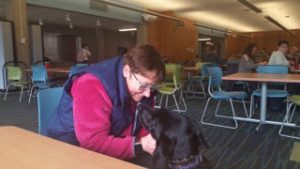by Christine Nelson
Journalism I

Professor Collene Thaxton with service dog Puma
You may have seen Professor Collene Thaxton and her service dog Puma together on campus, both at Gardner and Devens. You may even have Thaxton as an instructor, as she is a Professor of Nursing. Thaxton has Type I diabetes. Puma is a service dog; his job is to let Thaxton know when her glucose levels are too low or too high. I was lucky to interview them both while Puma was off duty.
Why did you decide to get a service dog?
I have had Type I diabetes for many years. But I have a tendency to push myself to my limits. You don’t always feel it when your glucose levels are off. My husband also started travelling more with his job. We decided that I needed more support. Puma arrived into my life on September 24, 2015.

How does Puma help you?
Puma detects my glucose levels by smell. If a level is too low or too high, he will get my attention by raising his paw to me. He reminds me to stop, take a break, and check my glucose levels. He can also detect my glucose levels while I am sleeping. If they are off, he has been known to pace and drool.
Puma can detect a problem with my glucose levels before my glucose monitoring equipment can. This gives me more time to make corrections to my blood sugar. It fascinates me how accurate he is.
Puma, how should other people treat you while at school?
Ruf. Please don’t touch or pet me. I am working and I need to focus on Collene. Also try not to bump me in the hallways. Thanks.
How does he act at school?
He is very well behaved; he never barks. My students know to ignore him.
Puma, do you work 24/7?
Ruf. No, Collene gives me breaks for exercise. I love exercise, especially swimming and frisbee.
What are the challenges of having a service dog?
I have two other pet dogs (also labs) at home. And one is an alpha personality. When Puma first arrived, one of our dogs bit him on the mouth. Eventually we worked it out and they peacefully live together now.
Also, a service dog requires constant training (done by me) to keep his skills sharp. I do a lot of training during the summer time because that’s when we have more time. He comes back from the summer a new dog. Playtime is a great time to do training. Currently we are working on the task of “find it”, which involves finding a frisbee in the woods.
Where did Puma come from
Puma was trained to be a diabetic service dog for the first two years of his life. He was trained by the organization SDWR (Service Dogs by Warren Retriever Labs). And he has the patches to prove it! SDWR specializes in training dogs for a variety of health challenges, such as epilepsy, autism, PTSD, and diabetes.
Comments are closed.